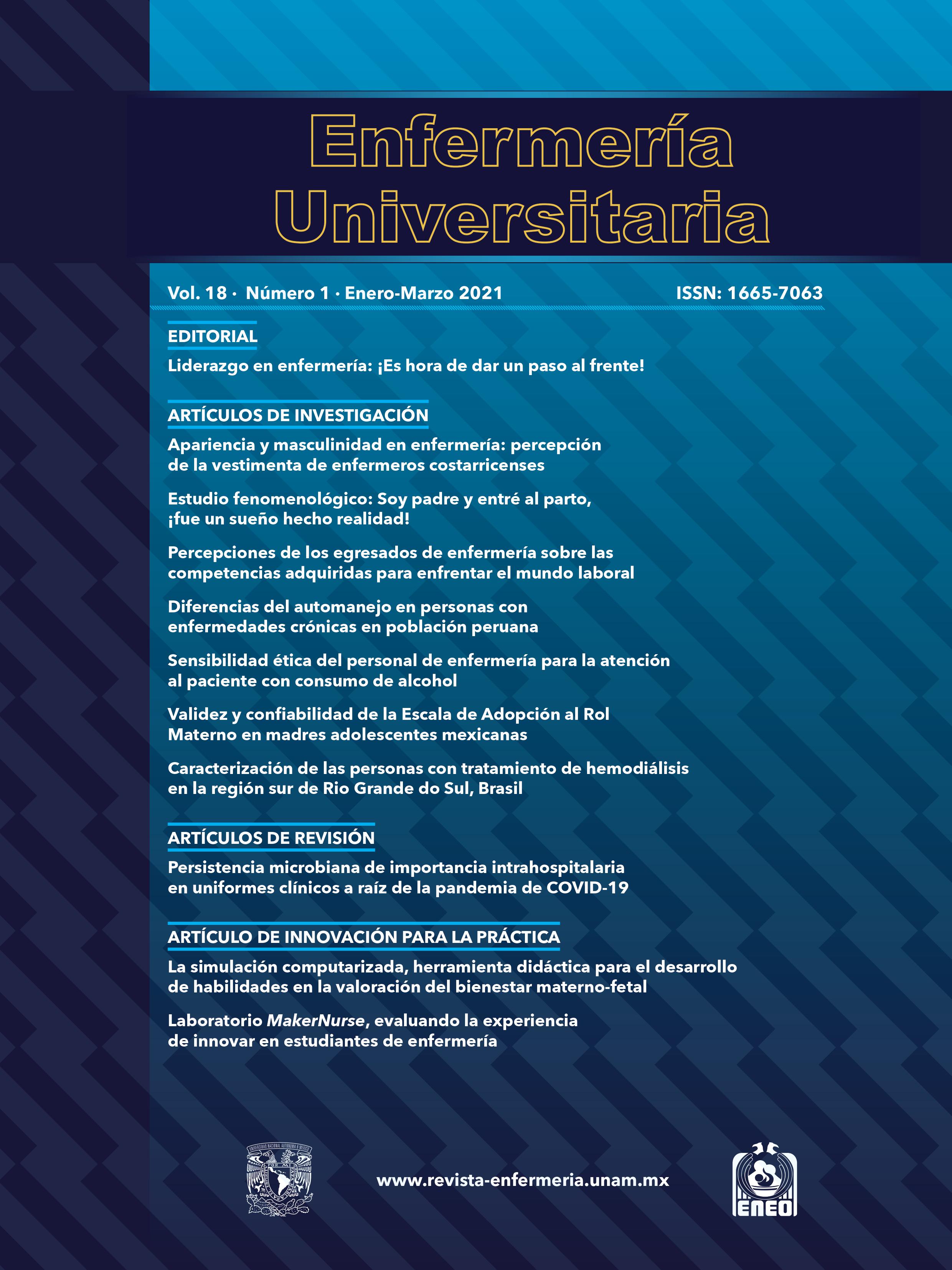Appearance and masculinity in nursing: perception about the outfit of male nurses in Costa Rica
Main Article Content
Abstract
Introduction: Historically, the white uniform has characterized the nursing profession. Nevertheless, currently, there is a wide variety of nursing outfit styles which are transforming the perception about the profession, including aspects related to the organization and social image.
Objective: To analyze the impact of appearance in the construction of the social image of nursing from the perception of male nurses regarding their uniform. Methods: An in-depth interview was conducted on 8 male nurses from Costa Rica in order, from an interpretative phenomenological frame, to better understand the meaning of the male nurses' lived experiences in the profession. These interpretative inferences based on nursing theoretical frames allowed an organization of the nurses' experiences into thematic units.
Results: Diverse themes emerged including: nurses dress in white; the variations in the nursing outfit denote social hierarchies; male nurse add elements to their outfits in order to be specifically identified and attributed with a masculine image of higher social prestige.
Conclusions: Male nurses accept the use of a white, or colored uniform for those subordinated staff; however, higher rank male nurses prefer wearing regular civil outfit, considering it as a reinforcement of their status or position of power and authority which should imply a higher social status.
Publication Facts
Reviewer profiles N/A
Author statements
- Academic society
- N/A
- Publisher
- Universidad Nacional Autónoma de México
Article Details
Dimensions citation
MÉTRICAS
References
2. Kalisch B, Kalisch P. Dressing for success. Am J Nurs. 1985; 85(8): 887-93. https://bit.ly/3hHirc9
3. Skorupski VJ, Rea RE. Patients’ perceptions of today’s nursing attire. J Nurs Adm. 2006; 36(9): 393-401. https://doi.org/10.1097/00005110-200609000-00005
4. Lennon SJ, Davis LL. Clothing and human behavior from a social cognitive framework part I: Theoretical perspectives. Cloth Text Res J. 1989; 7(4): 41-8. https://doi.org/10.1177/0887302X8900700406
5. Clavelle JT, Goodwin M, Tivis LJ. Nursing professional attire. J Nurs Adm. 2013; 43(3): 172-7. https://doi.org/10.1097/NNA.0b013e318283dc78
6. Timmons S, East L. Uniforms, status and professional boundaries in hospital. Sociol Health Illn. 2011; 33(7): 1035-49. https://doi.org/10.1111/j.1467-9566.2011.01357.x
7. León-Román CA. El uniforme y su influencia en la imagen social. Rev Cubana Enfermer. 2006; 22(1): 1-6. https://bit.ly/3fBbTJG
8. Miller T, Mann N, Grim RD. Clothes encounter: Patient perception of nursing attire in a behavioral health unit. J Am Psychiatr Nurses Assoc. 2010; 16(3): 178-83. https://doi.org/10.1177/1078390310370621
9. Thomas CM, Ehret A, Ellis B, Colon-Shoop S, Linton J, Metz S. Perception of nurse caring, skills, and knowledge based on appearance. J Nurs Adm. 2010; 40(11): 489-97. https://doi.org/10.1097/NNA.0b013e3181f88b48
10. Solano-López AL. La imagen social de la enfermería en Costa Rica y su construcción desde la autoimagen profesional. Enferm. actual Costa Rica. 2012; 33(2): 54-6. https://bit.ly/3hImOUk
11. Alvarado-Quijano G, Alvarado-Rodríguez E, Barboza-Picado A, Castro-González É, León-Morales S, Matarrita-Matarrita A, et al. Definición de enfermería en el tercer nivel de atención según los acompañantes de los usuarios de un hospital costarricense. Enferm. actual Costa Rica. 2008; (14):1-10. https://bit.ly/2QHuY4w
12 Retana C. Las artimañas de la moda: una genealogía del poder vestimentario. San José, Costa Rica: Arlekín; 2015.
13. Polit DF, Beck CT. Nursing research: Generating and assessing evidence for nursing practice. 9th ed. Philadelphia: Lippincot Williams & Wilkins; 2012.
14 Packer MJ. La ciencia de la investigación cualitativa. Bogotá: Uniandes; 2013.
15. Tuohy D, Cooney A, Dowling M, Murphy K, Sixsmith J. An overview of interpretive phenomenology as a research methodology. Nurse Res. 2013; 20(6): 17-20. https://n9.cl/18lmf
16. Cisterna-Cabrera F. Categorización y triangulación como procesos de validación del conocimiento en investigación cualitativa. Theoria. 2005; 14(1): 61-71. https://bit.ly/3vbfO6C
17. Martínez-Miguelez M. Comportamiento Humano. Nuevos mátodos de investigación. 2ª ed. México: Trillas; 1996.
18. Connell RW. Masculinities. 2nd ed. California: University of California Press; 2005.
19 Connell R, Pearse R. Género desde una perspectiva global. Valencia: Universitat de València; 2018.
20. Connell RW, Messerschmidt JW. Masculinidade hegemônica: Repensando o conceito. Rev. Estud. Fem. 2013; 21(1): 241-82. https://doi.org/10.1590/S0104-026X2013000100014
21. Messerschmidt JW. Engendering gendered knowledge: Assessing the academic appropriation of hegemonic masculinity. Men Masc. 2012; 15(1): 56-76. https://doi.org/10.1177/1097184X11428384
22. Tennent E. Book Reviews. The fashioned body: Fashion, dress & modern social theory Joanne Entwistle. Fem Psychol. 2018; 28(2): 292-306. https://doi.org/10.1177/0959353516682662
23. Ruetzler T, Taylor J, Reynolds D, Baker W, Killen C. What is professional attire today? A conjoint analysis of personal presentation attributes. Int J Hosp Manag. 2012; 31(3): 937-43. https://doi.org/10.1016/j.ijhm.2011.11.001
24. Petrilli CM, Mack M, Petrilli JJ, Hickner A, Saint S, Chopra V. Understanding the role of physician attire on patient perceptions: A systematic review of the literature-targeting attire to improve likelihood of rapport (TAILOR) investigators. BMJ Open. 2015; 5(1): 1-18. https://doi.org/10.1136/bmjopen-2014-006578
25 Clow KA, Ricciardelli R, Bartfay WJ. Are you man enough to be a nurse? The impact of ambivalent sexism and role congruity on perceptions of men and women in nursing advertisements. Sex Roles. 2015; 72: 363-76. https://doi.org/10.1007/s11199-014-0418-0
26. Porr C, Dawe D, Lewis N, Meadus RJ, Snow N, Didham P. Patient perception of contemporary nurse attire: A pilot study. Int J Nurs Pract. 2014; 20(20): 149-55. https://doi.org/10.1111/ijn.12160

This work is licensed under a Creative Commons Attribution-NonCommercial-NoDerivatives 4.0 International License.
Enfermería Universitaria by Universidad Nacional Autónoma de México it is distributed under the License Creative Commons Attribution - NonCommercial - NoDerivatives 4.0 International
Accepted and published articles become open-access under the terms of the Creative Commons CC BY-NC-ND 4.0 license, which authorizes the reproduction and sharing without commercial purposes, provided the corresponding acknowledgments to their authors. Authors are allowed to manage a self-archive copy of the article’s published version so that they can open-access it in their personal or institutional web pages, and/or any other broad-diffusion space.





